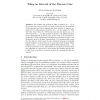Free Online Productivity Tools
i2Speak
i2Symbol
i2OCR
iTex2Img
iWeb2Print
iWeb2Shot
i2Type
iPdf2Split
iPdf2Merge
i2Bopomofo
i2Arabic
i2Style
i2Image
i2PDF
iLatex2Rtf
Sci2ools
CPM
2006
Springer
2006
Springer
Tiling an Interval of the Discrete Line
We consider the problem of tiling a segment {0, . . . , n} of the discrete line. More precisely, we ought to characterize the structure of the patterns that tile a segment and their number. A pattern is a subset of N. A tiling pattern or tile for {0, . . . , n} is a subset A P(N) such that there exists B P(N) and such that the direct sum of A and B equals {0, . . . , n}. This problem is related to the difficult question of the decomposition in direct sums of the torus Z/nZ (proposed by Minkowski). Using combinatorial and algebraic techniques, we give a new elementary proof of Krasner factorizations. We combinatorially prove that the tiles are direct sums of some arithmetic sequences of specific lengths. Besides, we show there are as many tiles whose smallest tilable segment is {0, . . . , n} as tiles whose smallest tilable segment is {0, . . . , d}, for all strict divisors d of n. This enables us to exhibit an optimal linear time algorithm to compute for a given pattern the smallest ...
Related Content
| Added | 20 Aug 2010 |
| Updated | 20 Aug 2010 |
| Type | Conference |
| Year | 2006 |
| Where | CPM |
| Authors | Olivier Bodini, Eric Rivals |
Comments (0)

